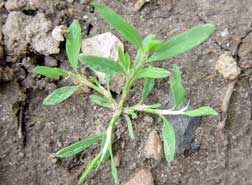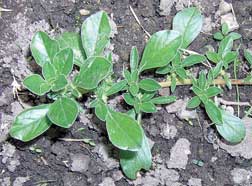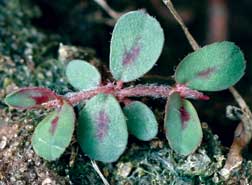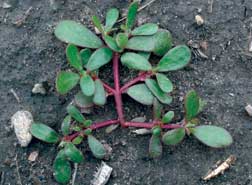Scouting for weeds: prostrate knotweed, prostrate pigweed, prostrate spurge and common purslane
Editor’s note: This article is from the archives of the MSU Crop Advisory Team Alerts. Check the label of any pesticide referenced to ensure your use is included.
Landscape
professionals and homeowners may encounter some common weeds in
landscape beds, gardens and driveways with a prostrate, mat-forming
growth. Four of the most common low-growing, summer annual weeds include
prostrate knotweed, prostrate pigweed, prostrate spurge and common
purslane. While similar in habit, these plants have specific
characteristics that aid in their identification (see below). Just as
with any other pest, correct weed identification is the first step to
creating an integrated weed management program.
Editor’s note: The identification information is from the new field guide An IPM Pocket Guide for Weed Identification in Nurseries and Landscapes. For ordering information, call 517-353-6740 or visit: http://www.ipm.msu.edu/pdf/pocketGuidesLandsc07.pdf
Prostrate knotweed: Polygonum aviculare L. (view photo)
Life cycle: Prostrate, mat-forming summer annual.
Leaves: Alternate, narrow oval to oblong leaves with pointed tips, smooth margins and short petioles.
Stems: Prostrate, tough, wiry stems with distinct nodes are
highly branched and mat-forming. Plants perform well in compacted areas.
A membranous sheath (ocrea) surrounds the stem at the base of each
petiole
Flowers and fruit: Small, inconspicuous flowers are white to
pinkish and clustered in the leaf axils. The seed is enclosed in a
single-seeded, dark reddish brown, three-sided fruit.
Reproduction: Seeds.
Prostrate pigweed: Amaranthus blitoides S. Wats. (view photo)
Life cycle: Prostrate, mat-forming summer annual.
Leaves: Alternate and pale green to shiny, dark green leaves
are oblong, oval to egg-shaped with pointed, rounded to slightly
indented leaf tips. Leaf margins are smooth and usually whitish. Leaves
are numerous at the stem ends.
Stems: Prostrate and nearly smooth, light green to red-dish
stems form thick, circular mats. Stems may be 1 to 3 feet long and
mostly erect at the tip.
Flowers and fruit: Small, greenish flowers are found in dense
clusters in the leaf axils. Flowers have bracts as long as the sepals
and yield small, round, shiny black seeds.
Reproduction: Seeds.
Prostrate spurge: Chamaesyce humistrata (Engelm. ex Gray) Small (view photo)
Life cycle: Prostrate summer annual.
Leaves: Cotyledons are oval with maroon undersides and short
petioles. Opposite, pale green, egg-shaped leaves with rounded tips have
small, irregular teeth along the margins and short petioles. The upper
leaf surface often has a maroon watermark.
Stems: Prostrate, densely hairy stems are highly branched from
the base, forming circular mats up to 16 inches in diameter. Stems may
root at the lower nodes and exude a milky sap when damaged.
Flowers and fruit: Inconspicuous flowers are formed in the leaf
axils. Fruit are hairy, three-lobed capsules that contain three
wrinkled, three-sided, pale brown seeds.
Reproduction: Seeds.
Similar weeds: Spotted spurge [Chamaesyce maculata (L.) Small]
Differs by having stems that do not root at the nodes, narrow oval to
oblong leaves, and ridged, not wrinkled, seeds.
Common purslane: Portulaca oleracea L. (view photo)
Life cycle: Prostrate, mat-forming summer annual.
Leaves: Cotyledons are oblong, hairless and succulent.
Cotyledons and young leaves are maroon-tinted on the undersides. Thick,
fleshy, succulent leaves are hairless, spatula-shaped and about 1 inch
long or less. Leaves are alternate but appear opposite and are often
crowded near the stem tips.
Stems: Prostrate, purplish red or green stems have multiple
branches that form circular mats. Stems are thick, fleshy, succulent and
hairless and up to 20 inches long.
Flowers and fruit: Small, yellow, star-shaped flowers with five
petals are produced in the leaf axils, opening only on sunny mornings.
Fruit are egg-shaped capsules that split around the middle, scattering
many tiny, black, shiny seeds.
Reproduction: Seeds.



 Print
Print Email
Email








